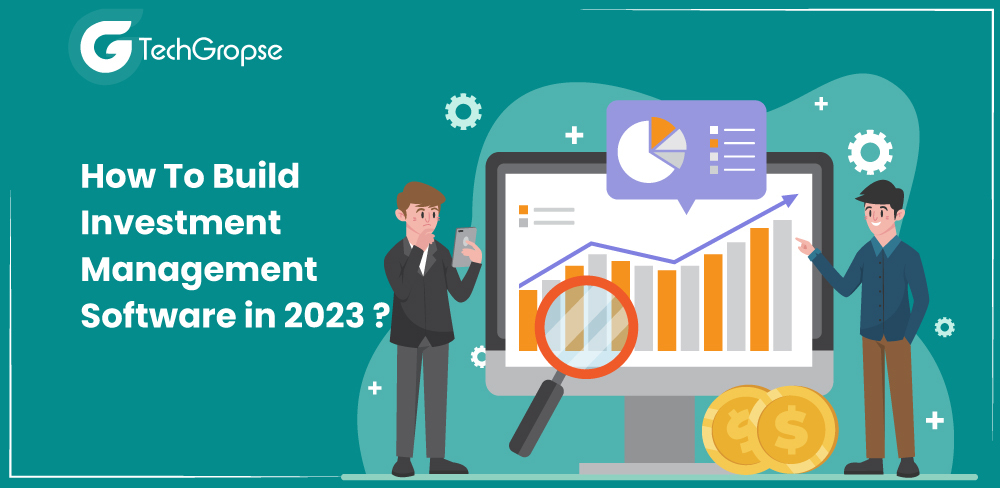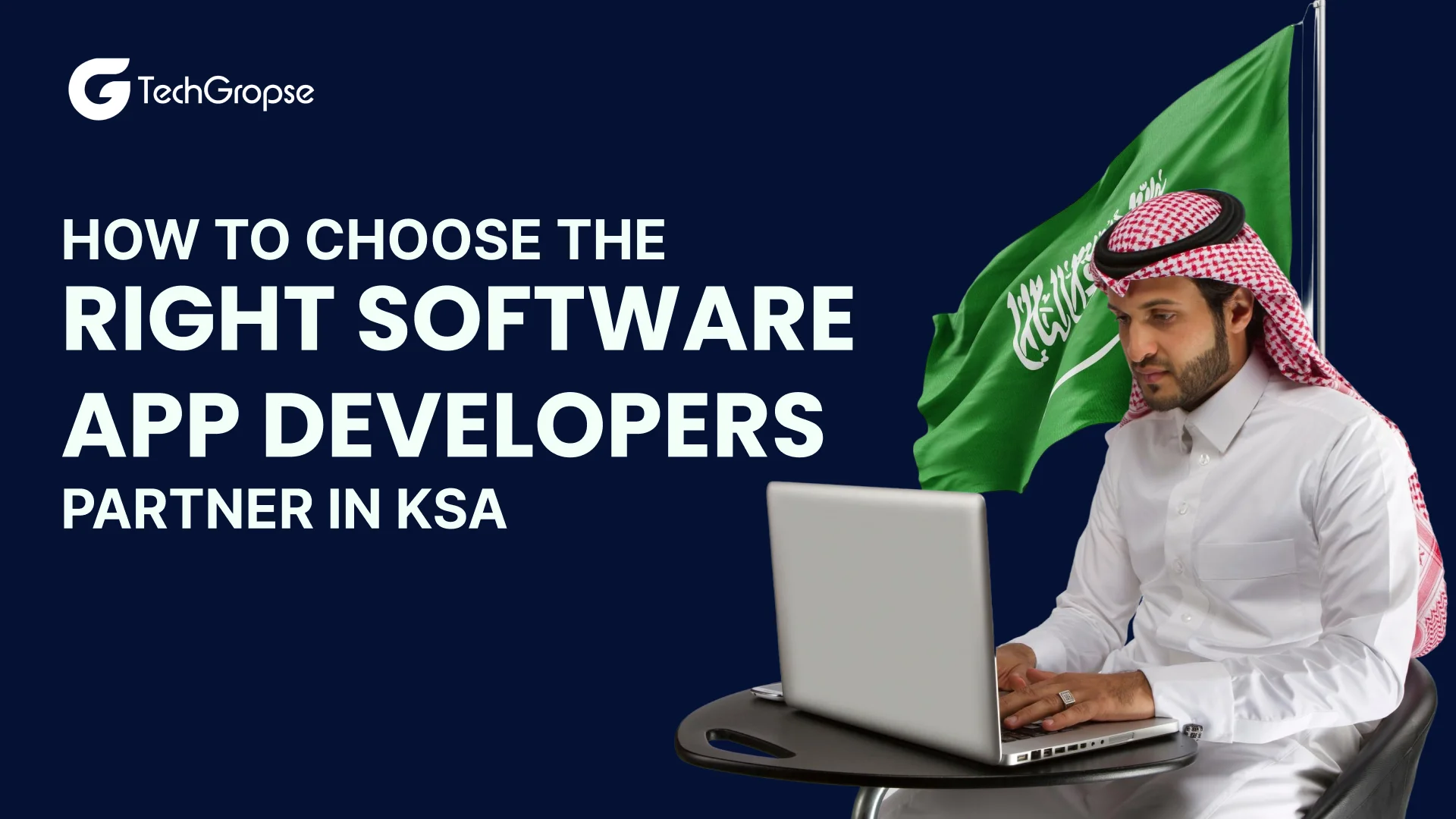In 2023, Investment Management Software enters a dynamic world described by technological innovation and growing investor demands. This investment manager software landscape has been reshaped by the quick integration of machine learning (ML), and artificial intelligence (AI) and facilitating data-driven decision-making and precision in portfolio management.
Furthermore, the integration of blockchain technology, the advancement of cryptocurrencies, and increasingly rigid regulatory needs have driven investment management software to new heights of compliance and security.
Investment portfolio management software plays a crucial role in the financial industry, providing powerful tools and solutions for investment professionals to efficiently manage portfolios, analyze market data, and make informed investment decisions.
As the year 2023 approaches, it becomes important to understand the modern trends and best practices in building investment management software.
Clients can expect a more interesting experience through real-time insights, and user-friendly interfaces, all while environmental, social, and governance (ESG) aspects are factored into investment strategies.
This introduction sets the stage for a software landscape that not only maximizes returns but also aligns with the importance and aspirations of today’s investors.
This post explores the key considerations, challenges, and strategies involved in creating investment management software in 2023, offering valuable insights for financial institutions, software developers, and stakeholders looking to trend technology to boost their investment management processes.
What is Investment Management Software?
Investment management software is like having a smart financial advisor in your pocket, without fancy suits and condescending accents. It is an advancement tool that assists individuals and organizations manage their investments more effectively and efficiently. Whether you are an experienced investor or just trying to dip your toes into the financial waters, this investment portfolio manager software can be your secret weapon.
Investment Management Software development is a category of real estate investment management software and tools designed to help individuals, investment professionals, and financial institutions in effectively managing and optimizing their investment portfolios.
This software is used across different segments of the financial industry, such as hedge funds, asset management firms, pension funds, and individual investors.
What is the Importance of Investment Management Software
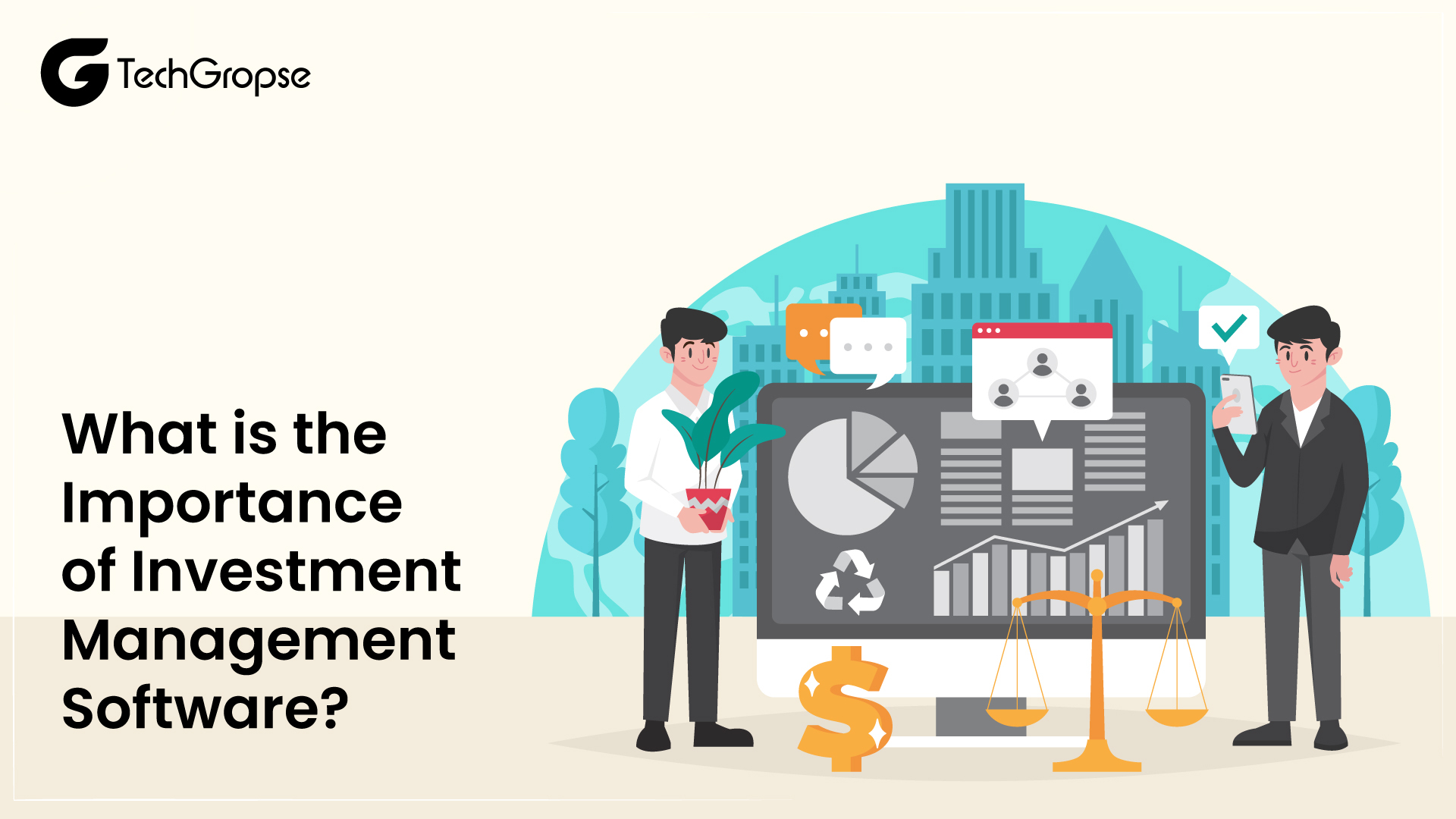
Did you think, why is investment management software essential, you ask? Well, let’s face it – investing can be overwhelming. From analyzing market trends to tracking portfolio performance, there is a lot to keep up with. That’s where investment management software comes to the rescue.
It simplifies the process, automating tedious tasks, delivering users valuable insights, and helping them make smarter investment decisions. Additionally, it saves you from spending countless hours poring over spreadsheets and financial reports. Ain’t Nobody got time for that!
| 1. Portfolio Optimization |
| – Ensures diversified, goal-aligned portfolios |
| – Optimizes asset allocation |
| 2. Data Analysis |
| – Provides access to extensive financial data |
| – Enables data-driven investment decisions |
| 3. Risk Mitigation |
| – Identifies and manages investment risks |
| – Conducts stress tests and risk assessments |
| 4. Efficient Trading |
| – Streamlines trading processes |
| – Reduces transaction costs |
| 5. Performance Tracking |
| – Monitors real-time investment performance |
| – Measures returns and benchmarks |
| 6. Compliance and Reporting |
| – Ensure adherence to regulatory standards |
| – Automates compliance checks and reporting |
| 7. Client Engagement |
| – Enhances client relationships |
| – Offers tailored investment strategies |
| 8. Cost Efficiency |
| – Reduces operational overhead |
| – Maximizes returns while minimizing costs |
| 9. Scalability |
| – Accommodates growing investor needs |
| – Handles larger portfolios and complexity |
| 10. Integration |
| – Streamlines workflows and data management |
| – Reduces manual data entry errors |
| 11. ESG Considerations |
| – Aligns portfolios with sustainability goals |
| – Incorporates ESG data and analysis |
| 12. Security |
| – Protects sensitive financial data |
| – Ensures data confidentiality and integrity |
The Process of Build Investment Management Software
Software development company follows careful planning, a deep understanding of the financial industry, and the integration of modern technologies.
Here is a step-by-step guide to help you get started:
1. Define Your Objectives and Target Audience:
- Clearly describe the objectives and goals of your software.
- Identify your target audience (e.g., wealth advisors, individual investors, asset managers,).
- Understand the specific requirements and pain points of your target users.
2. Market Research and Analysis:
- Mobile app development company conducts thorough market research to determine opportunities and gaps in the investment management software landscape.
- Analyze competitors to understand their strengths and weaknesses.
3. Compliance and Regulatory Considerations:
- Familiarize yourself with the regulatory needs that govern the financial industry in your target markets.
- Ensure that your software will fulfill compliance standards and offer features for regulatory reporting.
4. Design the UI/UX:
- Build a reflexive and user-friendly interface that caters to the requirements of your target audience.
- Design portfolio tracking tools, interactive dashboards, and reporting features.
5. Choose the Technology Stack:
- Select the right technology stack based on your needs. This can include databases, programming languages, and frameworks.
- Consider cloud-based solutions for scalability and accessibility.
6. Data Integration:
- Mobile app developers establish data connections with financial data providers, market data feeds, and custodians to ensure real-time and accurate data.
- Implement data security measures to protect sensitive financial details.
7. Features and Functionality:
- Dedicated developers help to design advanced features like risk assessment, portfolio management, asset allocation, and reporting.
- Consider implementing ML/AI algorithms for predictive analytics and automated decision-making.
- Include tools for ESG analysis and cryptocurrency management if relevant.
8. Mobile Compatibility:
- Ensure that your software is responsive and compatible with mobile devices, as many users prefer to access their investments on smartphones and tablets.
9. Testing and Quality Assurance:
- Real estate app development company performs strict testing to determine and fix any bugs or issues.
- Conduct security testing to protect against cyber threats.
- Ensure the software performs well under different scenarios and user loads.
10. Compliance Features:
- Build features that help users in adhering to regulatory compliance.
- Implement reporting tools, audit trails, and other compliance-related features.
11. Security Measures:
- Prioritize cybersecurity with authentication, robust encryption, and access control mechanisms.
- Regularly update and patch the software to manage security vulnerabilities.
12. Scalability and Performance Optimization:
- Design your software with scalability in mind to accommodate growing user bases and larger portfolios.
- Constantly optimize performance to provide responsive and efficient operation.
13. User Training and Support:
- Provide comprehensive training resources and support to users.
- Offer customer support channels for addressing queries and issues.
14. Launch and Marketing:
- Launch your investment management software with a targeted marketing campaign.
- Highlight its benefits, unique features, and how it addresses users’ pain points.
Emerging Technology Used to Build Investment Management Software in 2023
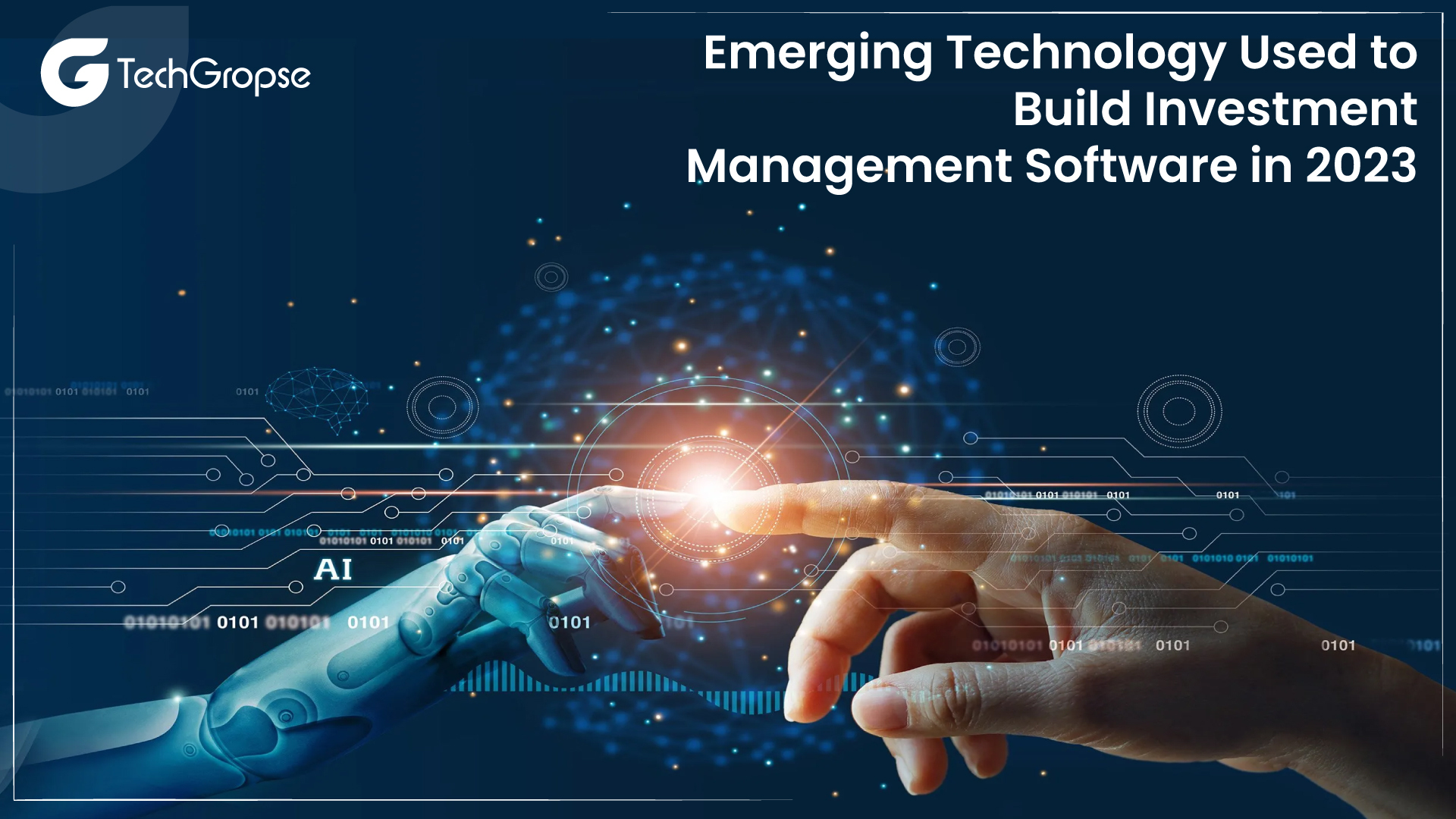
These emerging technologies are poised to enhance the capabilities and effectiveness of investment management software in 2023, making it more data-driven, secure, and responsive to the needs of investors and financial professionals.
| Emerging Technology | Description and Use Case |
| Artificial Intelligence (AI) and Machine Learning (ML) | ● Predictive analytics for portfolio optimization, risk assessment, and trading strategies.
● Chatbots for user support. |
| Blockchain Technology | ● Secure and transparent transaction records.
● Automating settlements. ● Managing digital assets, including cryptocurrencies. |
| Robotic Process Automation (RPA) | ● Automating repetitive and rule-based tasks to increase efficiency and reduce costs. |
| Big Data Analytics | ● Processing vast financial and market data in real-time for informed investment decisions. |
| Quantum Computing | ● Performing complex calculations at high speeds for financial modeling and risk analysis. |
| Natural Language Processing (NLP) | ● Analyzing textual data for market sentiment and valuable insights. |
| Cloud Computing | ● Scalable infrastructure for data storage, processing, and accessibility. |
| Edge Computing | ● Reducing latency and enhancing real-time analytics for low-latency market data access. |
| Cybersecurity Advances | ● Advanced encryption, multi-factor authentication, and threat detection systems. |
| Extended Reality (XR) | ● Data visualization and financial modeling in immersive VR and AR environments. |
| IoT Sensors | ● Real-time data collection for investment decisions, e.g., in manufacturing or logistics. |
| API Integration | ● Seamless integration with data providers, financial systems, and market exchanges. |
| Quantum Cryptography | ● Ensuring secure financial transactions and data protection against quantum computing threats. |
| 5G Connectivity | ● Ultra-fast networks for real-time data transmission, especially important for traders. |
Key Trends and Challenges in Investment Management Software Development
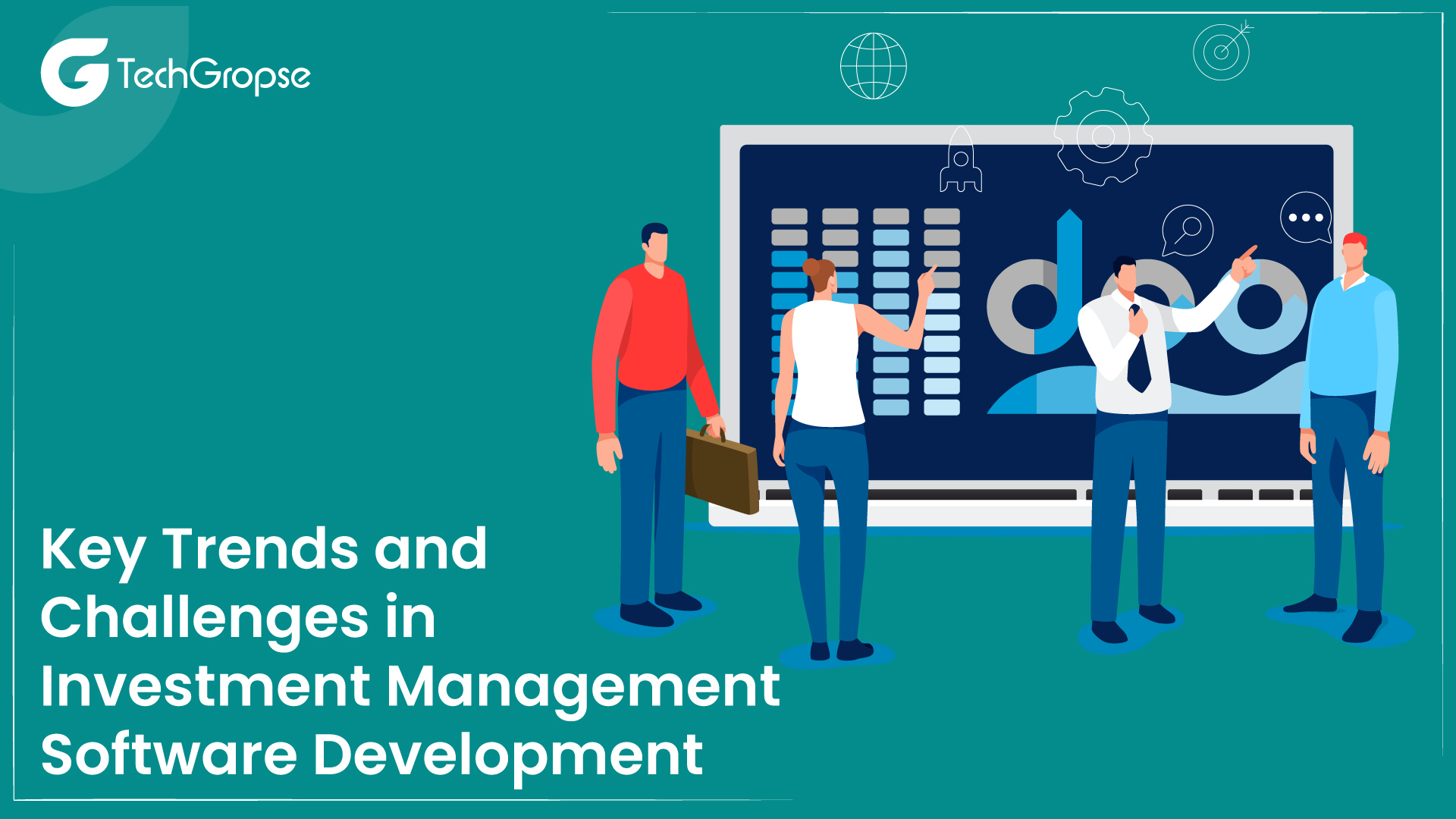
Investment management software development is a vibrant field, constantly growing to satisfy the changing needs of investors, financial institutions, and regulatory environments.
Here are some essential trends and challenges in investment management software development:
#Trends
- Machine Learning and Artificial Intelligence (AI/ML): AI and ML are transforming the investment management industry. These technologies are used for portfolio optimization, predictive analytics, and risk assessment. AI-driven algorithms can process extensive datasets and recognize patterns that human analysts could miss.
- Robo-Advisors: Robo-advisory platforms are acquiring popularity. They offer algorithm-driven portfolio management services, automated, making investing more accessible and cost-effective for a more expansive range of investors.
- Data Analytics: Advanced data analytics tools are crucial for making informed investment decisions. Big data processing, real-time data integration, and predictive analytics are evolving standard features in investment management software.
- ESG Integration: Social, and Governance (ESG), and environmental, aspects are considered in investment decisions. Software development must integrate ESG data and analysis tools to assist investors align their portfolios with sustainability goals.
- Cryptocurrency and Blockchain Integration: With the growth of blockchain and cryptocurrency technology, investment management software may require to include features for managing digital assets and ensuring secure transactions.
- Regulatory Compliance: Regulatory necessities are frequently changing, posing a challenge for software developers. Investment management software must remain up-to-date with developing regulations and deliver compliance features.
- Client-Centric Solutions: Clients expect more personalization and transparency. Software development should focus on real-time reporting, user-friendly interfaces, and customization options to improve the client experience.
- Cybersecurity: As financial data becomes digital, cybersecurity is a top concern. Software developers must implement robust security measures to protect sensitive details from cyber threats.
#Challenges
- Data Security and Privacy: With the rising use of cloud-based solutions and the storage of sensitive financial data, ensuring data security and privacy remains a significant challenge. Developers must implement access controls and strong encryption.
- Complex Integration: Integrating with various data providers, custodians, and other financial systems can be complex. Software development company must create solutions that seamlessly connect with external services while maintaining data integrity.
- Regulatory Compliance: Compliance necessities differ by jurisdiction and change frequently. Keeping up with these changes and making compliance features into software is a constant challenge.
- Interoperability: Achieving seamless interoperability between different software systems and data formats is a persistent challenge, particularly in a complex financial ecosystem with legacy systems.
- Scalability: Investment management software can manage immense volumes of data and scale to accommodate growing portfolios and user bases. Scalability without compromising performance is a development challenge.
- AI Bias and Interpretability: ML and AI models can introduce bias into investment decisions, and their decision-making processes are challenging to interpret. Developers must address these issues to ensure transparency and fairness.
- Legacy Systems: Many financial institutions always depend on legacy systems, making transitioning to modern investment management software challenging. Developers may need to design solutions that combine with legacy systems or deliver migration paths.
- User Education: As software becomes more advanced, users, including investment professionals and clients, need to be educated on how to use these tools effectively and interpret their outputs accurately.
Who is the Target Audience of Investment Management Software Development
The target audience for investment management software development contains a range of stakeholders within the financial and investment industry. These audiences can be largely categorized into the following groups:
| Target Audience |
| 1. Asset Management Firms |
| 2. Hedge Funds |
| 3. Wealth Management Firms |
| 4. Pension Funds and Endowments |
| 5. Individual Investors |
| 6. Financial Advisors and Planners |
| 7. Compliance and Risk Management Professionals |
| 8. Portfolio Managers |
| 9. Traders |
| 10. Data Analysts |
| 11. Compliance Officers |
| 12. Technology Professionals |
| 13. Auditors and Regulators |
How Much Does It Cost To Real Estate App Development?
Please note that real estate app development cost ranges are general estimates and can differ widely based on your specific project’s unique needs, the expertise of the development team, and your geographic location.
To get an accurate estimate, it is advisable to consult with an experienced real estate app development company that can provide a detailed breakdown tailored to your project.
| Complexity Level | Cost Range |
| Simple Property Listing App | $5,000 – $20,000 |
| Property Search App | $20,000 – $50,000 |
| Real Estate Marketplace | $50,000 – $150,000 |
| Comprehensive Real Estate Portal | $150,000 – $500,000+ |
Additional Cost
| Additional Costs | Cost Range |
| Design (UI/UX) | $5,000 – $20,000 |
| Third-Party Integrations | Varies (can be significant) |
| Testing and Quality Assurance | $5,000 – $20,000 |
| Maintenance and Updates | Ongoing (monthly/yearly) |
| Marketing and Promotion | Varies (can be significant) |
Top Build Investment Management Software in 2023
With the right investment management software in place, financial institutions can enhance efficiency, improve decision-making capabilities, and ultimately achieve greater success in managing their investment portfolios.
Have a quick look at of these top tools can change over time.
| Portfolio Management Software | Description | Pros | Cons |
| 1. Morningstar Direct | Professional-grade portfolio analysis and reporting tool. | ● Robust data analysis and reporting features.
● Access to a wide range of market data and research. ● Supports performance attribution. Integration with other Morningstar products. |
● High pricing may not be suitable for individual investors.
● The steeper learning curve for beginners. |
| 2. eFront | Private equity and alternative investment software. | ● Specialized in private equity, real estate, and alternative investments. Advanced analytics and reporting capabilities.
● Integrates with various data sources. ● Scalable for institutional use. |
● Complex and may not be suitable for all investment types.
● Costly for smaller firms or individuals. |
| 3. Orion Advisor Tech | Wealth management platform with portfolio management. | ● Integrated platform for advisors and investors.
● Extensive reporting and billing capabilities. ● Support for model portfolios. Customizable for advisors’ specific needs. |
● Designed for wealth management professionals, may not be ideal for individual investors. Pricing can be high for smaller firms. |
| 4. Envestnet | PMC** | ● Integrated wealth management and portfolio analysis tool. | ● Comprehensive platform for advisors and wealth management.
● Robust portfolio analytics and reporting. ● Access to a broad range of investment solutions. Integrates with other Envestnet products. |
| 5. Addepar | Investment management and reporting platform. | ● Supports complex and multi-asset class portfolios.
● Real-time data visualization. ● Integrates with various data sources. ● Suitable for family offices and advisors. |
● Complex interfaces and features may be overwhelming for some users.
● Pricing is often customized and may be expensive. |
Final Thought
Building investment management software in 2023 needs a deep understanding of the industry’s growing landscape, technology advancements, and user needs.
By following the outlined strategies, adopting emerging trends, and addressing the challenges, software developers can create robust and cutting-edge solutions that empower investment professionals to thrive in today’s dynamic financial markets.
As we move forward, it is essential to stay agile, adapt to future changes, and continue innovating to satisfy the growing needs of the investment management industry.
So there you have it!
Good luck, and may your software be the Sherlock Holmes of investments.
FAQ: How To Build Investment Management Software in 2023
1. What are the essential benefits of using investment management software?
Investment management software offers various benefits, such as enhanced data analysis capabilities, streamlined portfolio management, improved risk assessment, automation of manual tasks, and increased efficiency in decision-making.
2. How can investment management software assist in mitigating risks?
Investment management software provides advanced risk management tools, like scenario analysis, risk assessment models, and stress testing capabilities. These features help in determining potential risks, estimating their impact on portfolios, and executing risk mitigation strategies.
3. What aspects should be considered when choosing investment management software?
When selecting investment management software, key factors to consider include the specific requirements and objectives of the financial institution, scalability and flexibility of the software, integration capabilities with existing systems, security features, ease of use, availability of customer support, and cost.






